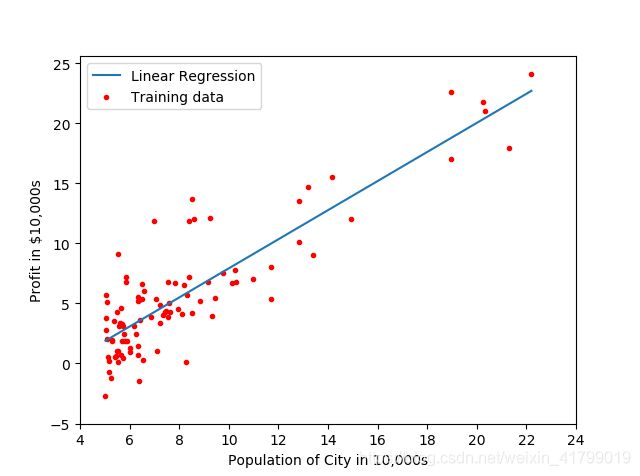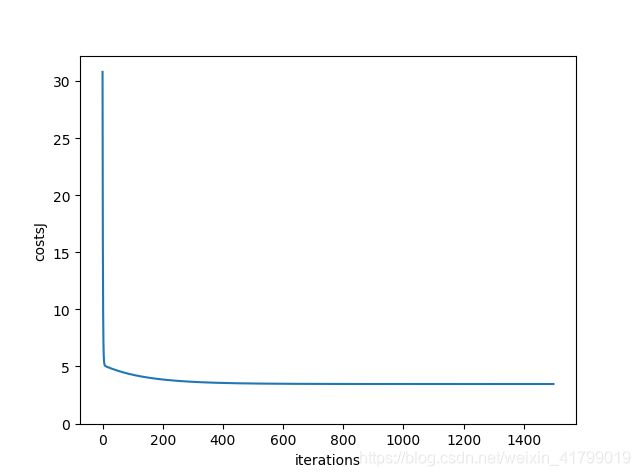吴恩达机器学习课后作业——线性回归(Python实现)
1.写在前面
吴恩达机器学习的课后作业及数据可以在coursera平台上进行下载,只要注册一下就可以添加课程了。所以这里就不写题目和数据了,有需要的小伙伴自行去下载就可以了。
作业及数据下载网址:吴恩达机器学习课程
2.单变量线性回归
单变量的线性回归的作业主要包含两个任务:进行拟合函数的绘制以及展示梯度下降的过程。下面附上代码,有详细的注释,这里就不一一解释了。
import pandas as pd
import numpy as np
import matplotlib
import matplotlib.pyplot as plt
#用于导入数据的函数
def inputData():
data=pd.read_csv('MachineLearning\\machine-learning-ex1\\machine-learning-ex1\\ex1\\ex1data1.txt')
data.insert(0,'ones',[1 for i in range(0,data.shape[0])]) #在dataframe在第一列中加入全为1的列
#以下是将dataframe中的数据转换为矩阵
X=data.iloc[:,0:2] #取出第1-2列的数据作为自变量
X=X.values
y=data.iloc[:,2] #取出第3列的数据作为因变量
y=y.values
y=y.reshape(y.shape[0],1) #注意这里,一行的数据最好使用reshape方法重构成向量,方便之后处理
return X,y
#用于计算代价函数
def computingTheCost(m,X,y):
costJ=(pow((X@theta-y),2)).sum()/(2*m) #根据吴恩达老师视频中的公式进行推导所得
return costJ
#用于进行梯度下降的函数
def gradientDescent(m,X,y,costs):
for k in range(0,iterations): #进行迭代
#以下完全根据吴恩达老师视频中进行编写代码
#使用@表示矩阵相乘,使用*表示两个同形矩阵对应数值相乘
temp0=theta[0]-alpha*(X@theta-y).sum()/m
temp1=theta[1]-alpha*((X@theta-y)*X[:,1].reshape(X.shape[0],1)).sum()/m #注意这里一定要将X[:,1]reshape成向量
costs[k]=computingTheCost(m,X,y) #调用计算代价的函数,记录当前的代价数值
theta[0]=temp0 #进行同步更新θ0和θ1
theta[1]=temp1
return theta,costs
#用于展示拟合函数
def showPrediction(X,y,theta):
c1=theta[0] #从theta中获得第一个参数θ0
c2=theta[1] #从theta中获得第二个参数θ1
xx=np.linspace(np.min(X[:,1]),np.max(X[:,1]),100) #使用linspace函数生成间隔均匀的数字
yy=c1+c2*xx #建立预测的表达式
#下面就是对于散点图以及拟合函数的绘制
plt.plot(xx,yy,label='Linear Regression') #绘制拟合函数
plt.scatter(X[:,1],y,c='red',marker='.',label='Training data') #绘制散点图
plt.xlabel('Population of City in 10,000s')
plt.ylabel('Profit in $10,000s')
x_ticks=np.arange(4,26,2)
y_ticks=np.arange(-5,30,5)
plt.xticks(x_ticks)
plt.yticks(y_ticks)
plt.legend(loc='best')
plt.show()
#展示梯度下降的情况
def showGradientDescent(costs,iterations):
#通过之前计算的代价函数,使用可视化的形式展现随着迭代的进行,代价函数下降的过程
plt.plot(np.arange(0,iterations,1),costs)
plt.xticks(np.arange(0,1600,200))
plt.yticks(np.arange(0,35,5))
plt.xlabel('iterations')
plt.ylabel('costsJ')
plt.show()
X,y=inputData() #导入数据
theta=np.zeros((2,1)) #使用0初始化θ数组
iterations=1500 #定义迭代的次数
alpha=0.02 #定义学习率α
costs=np.array([0.1 for i in range(0,iterations)]) #创建代价函数数组
theta,costs=gradientDescent(X.shape[0],X,y,costs) #进行梯度下降,返回最优θ和代价函数值
#showPrediction(X,y,theta) #用于展示拟合函数
#showGradientDescent(costs,iterations) #用于展示梯度下降的过程
3.多变量线性回归
单变量的线性回归的作业主要包含两个任务:对不同的学习率的梯度下降情况进行展示、分别利用正规方程和梯度下降进行预测。下面附上代码,有详细的注释,这里就不一一解释了。
import numpy as np
import matplotlib.pyplot as plt
import pandas as pd
#用于导入数据的函数
def inputData():
#注意这里最好指明导入数据的类型,因为后面会涉及到正规化,int和float不太一样
data=pd.read_csv('MachineLearning\\machine-learning-ex1\\machine-learning-ex1\\ex1\\ex1data2.txt'
,dtype={
0:float,1:float,2:float})
##在dataframe在第一列中加入全为1的列
data.columns=['size of house','num of room','price of room']
data.insert(0,'one',[1 for i in range(0,data.shape[0])])
#以下是将dataframe中的数据转换为矩阵
X=data.iloc[:,0:3] #取出第1-3列的数据作为自变量
X=X.values
y=data.iloc[:,3] #取出第4列的数据作为因变量
y=y.values
y=y.reshape(46,1) #注意这里,一行的数据最好使用reshape方法重构成向量,方便之后处理
return X,y
#用于进行特征缩放的函数(均值归一化)
def featureNormalize(data,b):
for i in range(0,b):
dataMean = np.mean(data[:,i]) #获取第i列的平均值
dataStd = np.std(data[:,i]) #获取第i列的标准差
for j in range(0,data.shape[0]): #遍历第i列中每一个数值
data[j,i] = (data[j,i]-dataMean)/dataStd #利用吴恩达老师的公式进行归一化
return data
#用于计算代价函数
def costs(m,theta,X,y):
costsJ= pow(X@theta-y,2).sum()/(2*m) #根据吴恩达老师视频中的公式进行推导所得
return costsJ
#用于进行梯度下降的函数
def gradientDescent(m,theta,alpha,iterations,X,y,costsC):
for i in range(0,iterations): #进行迭代
#以下完全根据吴恩达老师视频中进行编写代码
#使用@表示矩阵相乘,使用*表示两个同形矩阵对应数值相乘
temp0=theta[0]-alpha*((X@theta-y)*X[:,0].reshape(X.shape[0],1)).sum()/m #注意这里一定要将X[:,1]reshape成向量
temp1=theta[1]-alpha*((X@theta-y)*X[:,1].reshape(X.shape[0],1)).sum()/m
temp2=theta[2]-alpha*((X@theta-y)*X[:,2].reshape(X.shape[0],1)).sum()/m
costsC[0,i]=costs(m,theta,X,y) #调用计算代价的函数,记录当前的代价数值
theta[0]=temp0 #进行同步更新θ0和θ1和θ2
theta[1]=temp1
theta[2]=temp2
return costsC,theta
#用正规方程进行计算的函数
def normalEquation(X,y):
#利用numpy的linalg的线代函数库根据公式进行计算
return np.linalg.inv(X.T@X)@X.T@y
#利用正规方程的方法进行预测的函数
def predictThroughNormalEquation(X,y,size,num):
finaltheta=normalEquation(X,y) #调用正规方程的函数
predictValue=finaltheta[0][0]+finaltheta[1][0]*size+finaltheta[2][0]*num #构造表达式计算结果
print('predictThroughNormalEquation=',predictValue)
#展示不同学习率α的梯度下降情况
def showGradientDescent(X,y):
answer1 = featureNormalize(X[:,1:3],2) #调用归一化的函数
X[:,1]=answer1[:,0] #将结果写入X中
X[:,2]=answer1[:,1]
costsC=np.zeros((4,iterations)) #建立4个代价函数costs数组
for i in range(0,4): #分别遍历四种学习率α
temp=np.zeros((1,iterations)) #初始化一个临时的代价数组
theta=np.zeros((3,1)) #初始化一个θ数组
temp,theta = gradientDescent(X.shape[0],theta,alpha[i],iterations,X,y,temp) #调用梯度下降函数
costsC[i]=temp #将temp返回给代价函数数组
#下面就是用于展示四种学习率α的下降情况
x=np.arange(0,iterations)
plt.plot(x,costsC[0],c='r',label='alpha=0.3')
plt.plot(x,costsC[1],c='b',label='alpha=0.1')
plt.plot(x,costsC[2],c='y',label='alpha=0.03')
plt.plot(x,costsC[3],c='g',label='alpha=0.01')
plt.legend(loc="best")
plt.show()
#利用梯度下降的方法进行预测的函数
def predictThroughGradientDescent(X,y,size,num):
#特别注意:在进行预测的时候,同样需要对预测的size和num进行归一化
sizeMean = np.mean(X[:,1]) #计算房子大小的均值
sizeStd = np.std(X[:,1]) #计算房子大小的标准差
numMean = np.mean(X[:,2]) #计算房间数量的均值
numStd = np.std(X[:,2]) #计算房间数量的标准差
normalSize=(size-sizeMean)/sizeStd #房子大小归一化
normalnum=(num-numMean)/numStd #房间数量归一化
answer1 = featureNormalize(X[:,1:3],2) #对房子大小和房间数量进行归一化
X[:,1]=answer1[:,0]
X[:,2]=answer1[:,1]
alpha=0.3 #因为从比较上看,学习率0.3是效果最好的,所以这里选用0.3
costsC=np.zeros((1,iterations)) #初始化代价函数数组
theta=np.zeros((3,1)) #初始化θ数组
costsC,theta=gradientDescent(X.shape[0],theta,alpha,iterations,X,y,costsC) #进行梯度下降
predictValue=theta[0][0]+theta[1][0]*normalSize+theta[2][0]*normalnum #构造预测表达式
print('predictThroughGradientDescent=',predictValue) #打印预测值
alpha=[0.3,0.1,0.03,0.01] #学习率α数组
iterations=15 #迭代次数
X,y=inputData() #输入数据
# showGradientDescent(X,y) #展示不同学习率α的梯度下降情况
predictThroughNormalEquation(X,y,2400,3) #使用正规方程进行预测
predictThroughGradientDescent(X,y,2400,3) #使用梯度下降进行预测
结果展示:



